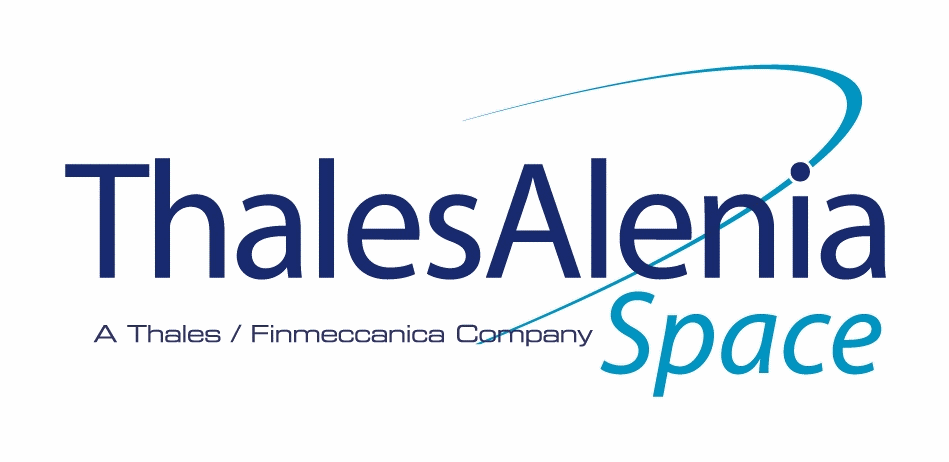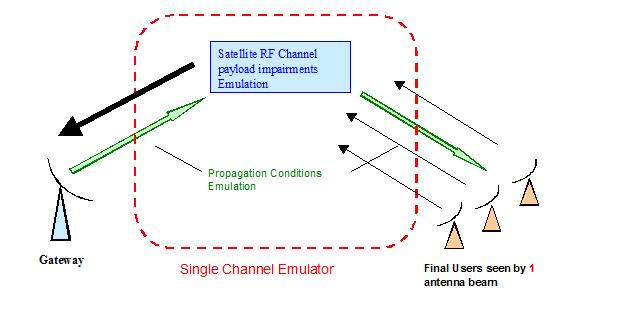
-
StatusOngoing
-
Status date2016-09-09
The Space-SCE targets very high capacity broadband payloads, which usually adopt multi-spot antenna technology and have very wide channel bandwidths (several hundreds of MHz).
It emulates both the forward and the return link, and is representative of the uplink, downlink, and payload transmission properties, i.e. propagation phenomena (Doppler/Delay, rain attenuation, etc.), additive interferences (including interferences due to frequency re-use), payload equipment responses (amplification non linearity representation, filtering impairments, phase noise, etc.).
The following figure shows the Single Channel Emulator within the system overview:

The objective is to develop Space Single Channel Simulator usable by all telecommunication satellite operators.
The key drivers are the ability to process a large bandwidth (600MHz), to implement specific link conditions foot pools of terminals and also to be operator friendly.
The demand of a new class of Satellite Payload channel emulators appears with the emergence of complex Multi-spot payloads which require extra care for system configuration and validation, including :
- A very wide instantaneous bandwidth (over 500 MHz)
- The emulation of the end to end satellite channel (uplink, downlink and payload impairments), taking into account all the preponderant effects in the link budget.
- The simultaneous emulation of different propagation conditions (up to 4 in Space SCE, with possibilities of further evolution), that allows the simulation of system capabilities such as Fade Mitigation Techniques.
- A very important quantity of connected terminals (up to 300).
Most of the demand for this kind of new product “Space-SCE” comes from satellite operators. However, it is considered broadening the potential customers by proposing a product that would also suit needs of the industrials (satellite manufacturers, terminal/VSAT modem suppliers...), in terms of system integration and validation.
The key factors identified, that make a product attractive:
- the performances to be reached in terms of bandwidth and emulated impairments.
- the level of abstraction of human-machine interface, usable by operators not necessarily aware of the full system definition or behavior.
The Space-SCE is used for:
- ground segment terminals validation
- payload investigation and/or situation inquiry when performances do not meet expectations.
- System Integration and Validation
In order to configure the Single Channel Emulator, a dedicated graphic user interface is developed, to enable the user to configure all the required parameters of the Space-SCE, to run a pre-programmed scenario and to collect emulation results.
Main drivers for Space-SCE development are :
- The ability to process a large bandwidth (600MHz) is clearly the key driver of the Space-SCE design. In particular, the nonlinear effects of the channel that are created by the amplifier function do require to work on the whole channel bandwidth to be realistic.
- The Space-SCE is able to further evolve and adapt to various broadband payloads and systems. All the effects that are emulated by the Single Channel Emulator are digitally processed.
- The Space-SCE is able to implement specific link conditions foot pools of terminals. On a given user RF link, some impairments are not the same, depending on the location of each terminal under the spot beam.
- The Space-SCE is operator friendly
The Space-SCE is designed to connect to real gateways and terminals, replacing completely the real satellite payload. On the Forward link, it processes a signal spanning up to 600 MHz bandwidth delivered by the Gateway, and delivers the aggregated spectrum to terminals where each band has a programmable central frequency.
The Space-SCE is designed to be representative of all transmission conditions.
The main sub-function blocks are :
- Payload Channel Emulator (PCE)
The PCE emulates all the effects of propagation and payload impairments on a very large bandwidth.
- Scenario configuration and scheduling tool (SCS)
The scenario configuration and scheduling tool handles :
- the configuration of an emulation scenario
- the scheduling of these emulation scenarii
- Payload Traffic Manager (PTM)
The PTM adds a high level of operability, in order to create an operational deployment of the terminals, and to create / evaluate the RF parameters that are associated to this deployment.
- Communication System Monitoring (CSM)
The CSM tool allows to monitor the signal at PCE output in L Band. A specific interface is designed to embed this already developed product in the Space-SCE.
- Satellite Data Base
The Satellite Data Base hosts the RF characteristics of the equipment embedded in the payload.
Design Phase:
This phase aims at defining a complete Design of the targeted solution for a Space-SCE.
Development and validation phase:
When the Space-SCE design is considered as mature, an industrial prototype version is developed and tested.
The project has been completed from design phase to operational hardware and software testing. A model is to be delivered soon for a commercial service.



